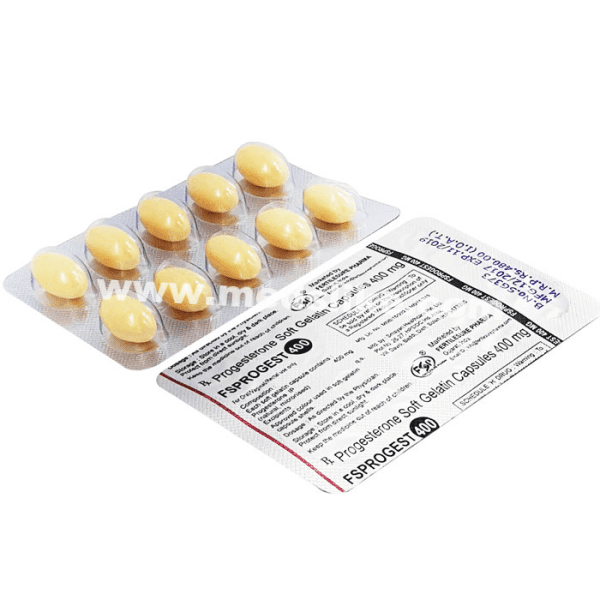What is Progesterone 400 mg?
Progesterone 400 mg is a high-dose formulation of the natural female hormone progesterone, used in hormone replacement therapy (HRT), infertility treatments, and menstrual disorders. It may be administered orally, vaginally, or rectally, depending on the formulation and therapeutic purpose.
What are the Uses of Progesterone 400 mg?
Progesterone 400 mg is used for:
In Women:
-
Supporting the luteal phase in assisted reproductive technologies (e.g., IVF)
-
Treating irregular menstrual cycles
-
Managing amenorrhea (absence of menstruation)
-
As part of hormone replacement therapy (HRT) to protect the uterus from estrogen-induced endometrial hyperplasia
-
Supporting early pregnancy in cases of luteal phase deficiency or recurrent miscarriage
In Men and Others (rare):
-
Occasionally in transgender care or hormone-sensitive cancer treatments (under specialist supervision)
What are the Benefits of Progesterone 400 mg?
-
Helps regulate menstrual cycles
-
Prepares the uterine lining for implantation and supports early pregnancy
-
Reduces risk of endometrial cancer when used with estrogen in HRT
-
Aids in the management of menstrual disorders
-
Promotes embryo implantation during IVF cycles
How Does Progesterone 400 mg Work?
Progesterone is a steroid hormone that plays a critical role in the menstrual cycle, pregnancy, and embryo development. It:
-
Prepares the endometrium for implantation of a fertilized egg
-
Maintains the endometrial lining during pregnancy
-
Modulates immune response during pregnancy
-
Regulates the effects of estrogen in the uterus
How to Take Progesterone 400 mg?
Administration Routes:
-
Orally: Swallowed as a capsule (may cause more systemic side effects like drowsiness)
-
Vaginally: Inserted directly, commonly used in IVF and HRT for direct uterine effect
-
Rectally: Sometimes used if vaginal route is not tolerated
Always follow the route and schedule advised by your doctor.
Dosage of Progesterone 400 mg
Typical dosages may include:
-
Luteal support in IVF: 400 mg once or twice daily, vaginally
-
HRT: 200–400 mg daily for 12–14 days per month (in women with intact uterus)
-
Amenorrhea: 400 mg daily for 10 days, cyclically
Doses vary based on indication, route, and individual factors.
Missed Dose and Overdose
Missed Dose:
-
Take it as soon as remembered.
-
Skip if it’s almost time for the next dose.
-
Do not double dose.
Overdose:
-
Symptoms may include drowsiness, dizziness, nausea, or vaginal bleeding.
-
Seek immediate medical attention if an overdose is suspected.
Available Strengths of Progesterone
-
100 mg
-
200 mg
-
300 mg
-
400 mg
Available in capsules, vaginal suppositories, or gel formulations.
Side Effects of Progesterone 400 mg
Common Side Effects:
-
Drowsiness or fatigue
-
Breast tenderness
-
Bloating
-
Mood changes
-
Vaginal discharge (with vaginal use)
Serious Side Effects:
-
Depression
-
Severe allergic reactions
-
Blood clots (rare)
-
Vaginal bleeding
Seek medical attention for unusual bleeding, swelling, or shortness of breath.
Interactions of Progesterone 400 mg
May interact with:
-
Anticonvulsants (e.g., phenytoin, carbamazepine)
-
Rifampin
-
St. John’s Wort
-
Ketoconazole
-
Estrogen-containing drugs (may increase side effects when combined)
Precautions of Progesterone 400 mg
-
Not suitable for women with:
-
Undiagnosed vaginal bleeding
-
Liver disease
-
Breast or genital cancers
-
History of thromboembolic disorders
-
-
Caution in patients with depression, migraines, or asthma
-
Regular monitoring and check-ups are important during long-term use
Storage Information
-
Store at room temperature (below 25°C / 77°F)
-
Keep away from heat, moisture, and light
-
Do not refrigerate unless specified
-
Keep out of reach of children
Availability in the US and Australia
-
Progesterone 400 mg is available in the US and Australia by prescription only.
-
Common brand names include:
-
Prometrium (oral)
-
Crinone (vaginal gel)
-
Endometrin, Cyclogest, or Utrogestan (vaginal/rectal)
-
Frequently Asked Questions (FAQs)
Q1: Can I use Progesterone 400 mg during pregnancy?
A: Yes, especially in cases of luteal phase defect or IVF, but only under medical supervision.
Q2: What’s the best time to take Progesterone?
A: Often taken at bedtime, especially when taken orally due to drowsiness. Follow your doctor’s advice.
Q3: Is it safe to use with estrogen?
A: Yes, in HRT, it is often combined with estrogen to protect the uterine lining.
Q4: Can it affect mood?
A: Some users experience mood swings or depressive symptoms. Report any significant changes to your doctor.
Q5: Is vaginal or oral progesterone better?
A: Vaginal progesterone tends to have fewer systemic side effects and better uterine absorption, especially for fertility support.

Reviews
There are no reviews yet.